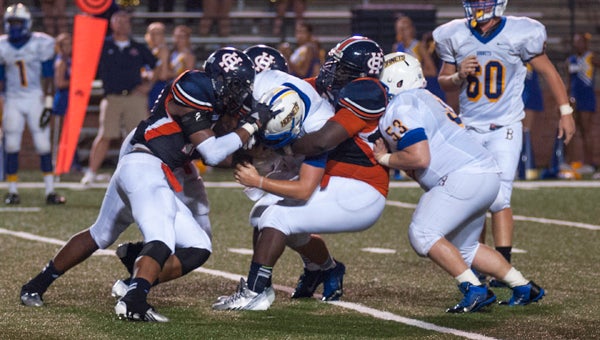Heads up
Published 10:35 pm Tuesday, June 10, 2014

New rules are in place to limit helmet-to-helmet hits in high school football. The NFHS recently adopted targeting rules like the NFL and college football.
Local football coaches weigh in on new targeting rule set to take effect in 2014
Things may be a little quieter on high school football fields this fall, thanks in large part to a new rule doctrine adopted by the National Federation of State High School Associations.
Like the NFL and college football have done in the past, the NFHS adopted a “targeting” rule in an attempt to limit helmet-to-helmet collisions and hard contact above the shoulders.
Effective with the 2014 high school season, new Rule 2-43 will read as follows: “Targeting is an act of taking aim and initiating contact to an opponent above the shoulders with the helmet, forearm, hand, fist, elbow or shoulders.” A new definition for a “defenseless player” was also added to Rule 2 for risk-minimization purposes. Rule 2-32-16 will read as follows: “A defenseless player is a player who, because of his physical position and focus of concentration, is especially vulnerable to injury.”
Troy area high school coaches agree the rule is a good one in terms of safety, but differ in ways of how the rule will be interpreted.
Interim Charles Henderson head coach Rodney Jordan says anything that can be done to make the game safer is ok in his eyes.
“I’m all for making the game safer,” Jordan said. “I don’t think it really changes anything technique wise for defensive backs or linebackers. The defensive backfield is all about leverage and you see that every time in the NFL. We, as coaches, have to coach our guys up and teach them to attack the body or swat the ball and not go after high hits.”
Goshen head coach Bart Snyder feels the rule is needed to limit the hard helmet-to-helmet contact, but he does have questions about how the rule will be enforced.
“It is going to be tough to cover from an official’s standpoint,” Snyder said. “Our officials have so much to watch for, and now we are asking them to make a big decision like that on a judgment call. It is sometimes hard for a DB to go up for a ball and judge where a receiver’s head is going to be seconds later. It will be tough for guys to get 15-yard penalties on plays where there was no intent there.”
One big difference in the college rule and the new high school rule is the lack of an ejection in high school. At the college level, a player cited for targeting a defenseless player is ejected for the remainder of the game. If the foul occurs in the second half of a game, the ejected player is also forced to sit out the first half of his team’s next game.
In college football however, the ejection can be overturned following a video review. With no video review available in high school, no ejections will be handed out. The targeting penalty will go down as a 15-yard unnecessary roughness call, and could be labeled as an unsportsmanlike conduct.
If a player gets multiple unsportsmanlike penalties, he can be disqualified from the remainder of the game and required to pay a fine to the Alabama High School Athletic Association before he is reinstated.
Bradley Bowers, head coach of the 2A Zion Chapel Rebels, likes the non-ejection approach.
“In five years, I think I have seen about two plays that could even be argued as targeting,” Bowers said. “But I know that at the small schools, ejections would have a huge impact. We have a bunch of guys that play both ways, and if someone were to get ejected on a judgment call, that would be a tough pill to swallow.”
Pike Liberal Arts coach Gene Allen said the utmost importance of the rule is safety.
“It is great from a safety aspect,” Allen said. “I’m sure things will take some getting used to for the players and the coaches. But in the long run everyone will adapt. The game will get a little safer and that is the main goal of the rule.”
The new rule takes effect this season.





